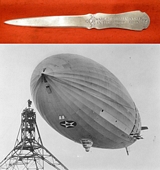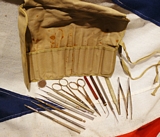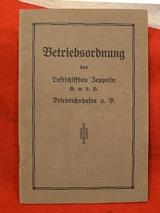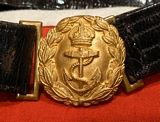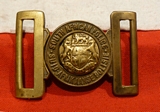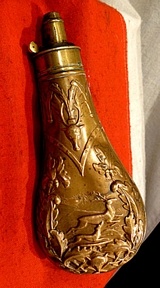An Original Desk Paperknife Made From Duralumin Of Airship USS Akron
Made from Duralumin taken from the construction of the airship. USS Akron (ZRS-4) was a helium-filled rigid airship of the U.S. Navy that was destroyed in a thunderstorm off the coast of New Jersey on the morning of 4 April 1933, killing 73 of her 76 crewmen and passengers. This accident was the largest loss of life for any known airship crash. During her accident-prone 18-month term of service, the Akron also served as a flying aircraft carrier for launching and recovering F9C Sparrowhawk fighter planes.
With lengths of 785 ft (239 m), 20 ft (6.1 m) shorter than the German commercial airship Hindenburg, Akron and her sister airship the Macon were among the largest flying objects in the world. Although the Hindenburg was longer, she was filled with hydrogen, so the two U.S. airships still hold the world record for helium-filled airships. read more
145.00 GBP
A WW2 Dental Instruments Medics Kit Roll
Very nice quality instruments that could likely work well today [after polishing and sterilising. read more
60.00 GBP
Operation of Regulations of Zeppelin Airship Construction in Freidrichafen
Published for the Zeppelin Co. in 10th Sept 1934. A paragraph withing the text makes a reference to the SA and SS but sadly as it is printed Gothic German it's devil to translate. The booklet contains operating istructions of the company including such details of working hours, winter and summer, and all manner of expected functions of the staff of the company. Not many of these documents survived. Dr Eckner is named on the last page as the company Fuhrer. The company that ran the Graf Zeppelin and Hindenberg transatlantic airships was the Nazi propaganda based company, titled the DZR, the Deutsche Zeppelin-Reederei. The DZR was created at the instigation of Air Minister Hermann G?ring as a way to increase Nazi control over zeppelin operations, and can be see as part of the larger policy of Gleichschaltung, or coordination, which affected all aspects of German life in the years following Hitler?s assumption of power.
Consistent with Nazi ideology, the airship was expected to be more than just a private commercial venture; it was to be a public symbol of the new German nation. In a speech marking the founding of the DZR, G?ring commented: ?I hope that the new ship will also fulfill its duty in furthering the cause of Germany? The airship does not have the exclusive purpose of flying across the Atlantic, but also has a responsibility to act as the nation?s representative.? read more
135.00 GBP
A WW1 Royal Naval Officer's Belt
Gilt bronze buckle with patent leather belt, however the belt is pretty worn and very small size. read more
85.00 GBP
A Sealed Pattern Zambia Armed Forces/Police Buckle
With original Crown Agents label. In mint condition. The first buckle made, and the one that all others must copy. read more
145.00 GBP
The 1970 Original Sealed Pattern Buckle of The Gambia Prisons
With original Crown Agents label and lead seal. The first and original buckle that all further buckles made were copied. A very rare collectors piece. read more
165.00 GBP
An Old, Brass, South African Police Buckle
With South African crest and name of force in English and Afrikaans. read more
95.00 GBP
A Very Fine. 19th Century Shaped Copper Powder Flask
With good adjustable spout measure and tight spring. read more
195.00 GBP
A Good French Boche Powder Flask, 19th Century, Shell Pattern
By Boche of Paris, a fine quality flask with good working spring action. Boche apparently signed only his best examples and flasks by Boche belong to the highest in society. read more
195.00 GBP
A Fine Victorian G & J W Hawksley Powder Flask
A very good copper and brass powder flask for a gun with the oak leaf design incorporating a fox and stag head, the nozzle stamped Drams and graduation values of 2?, 2?, 2? , the nozzle signed G & J. W. Hawksley, slight dent one side at the top of the body, and in working order. Overall 8 by 3? inches.
See THE POWDER FLASK BOOK, Ray Riling page 315 fig 580.
Riling says in the book that the flask illustrated as fig 580 was made by Hawksley for Barton of New York and implies that this was an exclusive design to them and does not mention having seen one marked Hawksley which might suggest that this is rare. read more
225.00 GBP


